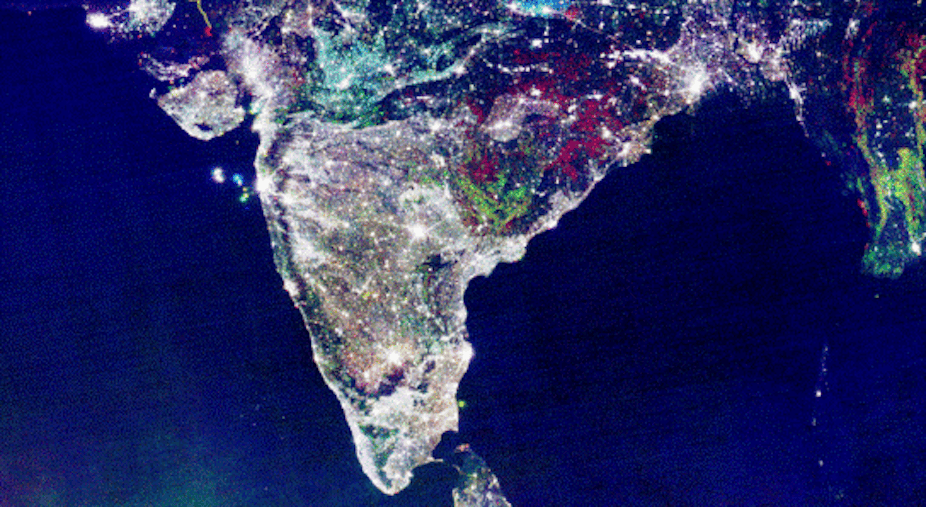As the Australian Labor Party changes its stance on trading uranium with India, a pertinent question arises: why is India so keen to buy this controversial fuel? And what do India’s energy resources look like, both fossil and renewable?
India has a population of 1.1 billion people, and 290 million of those people have no access to the electricity grid. Those that do have access to the grid use, on average, 2.7 kilowatt hours (kWh) of electricity per person, per day. Compare this to the 30 kWh the average Australian uses.
If all Indians gain access to the grid, and use just half the electricity of the average Australian, India would need an eight-fold increase in its generating capacity.
It’s all about coal …
India currently gets most of its electrical energy from coal-fired power stations (67%), with hydropower contributing 15% and gas 12%. Only 2% currently comes from nuclear power stations.
India has 90 Gigawatts (GW) worth of coal-fired power stations, compared with only 4 GW of nuclear capacity (for reference, the Hazelwood coal-fired station in Victoria has a capacity of 1.6 GW).
India has some 60 billion tonnes of coal in proven reserves. Australia has a bit more at 75 billion tonnes. But if India were to continue using coal to provide 70% of its electricity while increasing demand to 15 kWh per person per day, their coal reserves would last just 15 years. Burning that coal would see global carbon dioxide levels rise by 45 parts-per-million (ppm) – most of the 60 ppm buffer we have between today’s concentrations (390 ppm) and the levels considered allowable before climate change becomes unacceptably dangerous (450 ppm).
Even if India bought all of Australia’s coal reserves they would only buy themselves an additional 18 years of power generation. And even though gas is considered a transitional fuel, India has less than 1% of the world’s natural gas reserves. These factors make it clear that alternatives to fossil fuel need to be found.
What’s the alternative?
As demand for energy in India rapidly increases, they are already embracing renewable technologies including wind and solar. India has the fifth largest total capacity of wind power in the world with 15 GW of wind power installed. Australia has just over 2 GW of wind power capacity even though we have considerably better wind resources compared to India.
The Indian Wind Energy Association estimates a potential capacity of 65 GW of wind power. But the capacity already installed runs at just 15% capacity factor due to perverse incentives that encourage the building of turbines, but not the production of power. Some turbines run at just 10% capacity, well under the 25% capacity factor generally considered economically viable.
India has 35 GW of hydropower, with a further 37 GW under construction. In theory an additional 100 GW could be installed, but with great environmental damage. India’s solar resources are fair to good, and several GWs of generation are in the planning stage, and potentially 100s of GW could be installed.
But the variable nature of solar power, especially in a country with strong seasonal variability in cloudiness due to the monsoons will limit the practical amount of solar and wind power that can make up the total generation capacity. There is potential for around 10 GW of geothermal power, and between 10 and 20 GW of wave and tidal power could be harnessed.
Biomass could provide another 25 GW of power, but growing the fuel needed would put yet another pressure on a landscape that is already beyond carrying capacity.
One possible outcome
So, assuming all of these available options were exploited, that’s approximately 400 GW of generation capacity (not including solar). But it’s important to consider this figure in the context of projections from the International Energy Agency (IEA). The IEA suggests that India will need at least 500 GW of generation capacity by 2050 to satisfy its energy needs, but that number could be as high at 1300 GW.
Clearly, there is work to be done.
One scenario from the IEA shows India’s energy capacity increasing to 750 GW by 2050, with:
- 190 GW of solar
- 133 GW of gas
- 77 GW from coal with carbon capture and storage
- 76 GW from hydro
- 66 GW from wind
- 122 GW of nuclear power and
- 150 GW from other assorted technologies.
For this scenario to occur, a global carbon price of around $170 per tonne would be required, resulting in a 50% reduction in global carbon emissions compared with 2005 levels.
That leaves nuclear, right?
To power 122 GW of nuclear power stations, using current technology, India would need to import some 25,000 tonnes of uranium per year. In 2010, Australia (with 30% of global reserves and currently the third largest exporter) exported 7,000 tonnes of uranium.
So a drastic ramp-up in uranium mining would be needed if Australia was to help meet India’s requirements. If similar increases in nuclear power are seen in other countries, a shift to Generation IV reactors (that use far less uranium) is required.
The challenge to install enough generating capacity to power India through its economic rise from poverty is great. Many hurdles need to be overcome, including an inefficient grid, perverse green incentives, and an electricity pricing system that discourages investment (currently domestic users pay less than industry per kWh).
To avoid dramatic increases in carbon emissions will require significant uptake of renewable technologies, but this alone cannot meet demand. Nuclear power will be required if India is to meet its long-term energy goals.

